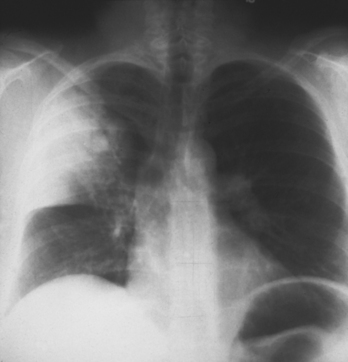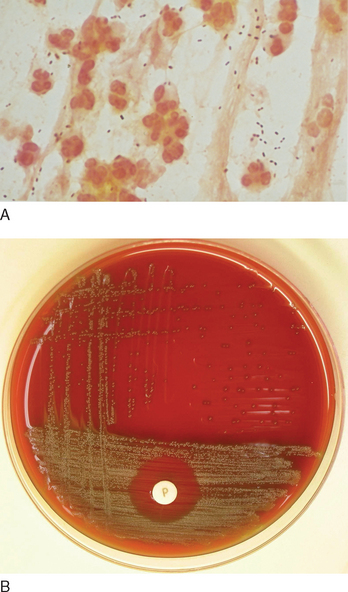CASE 9
A 67-year-old white man was brought by his wife to the ED for the abrupt onset of shaking chills, high fever, and pain on the right side of his chest that began the prior evening. His wife reported that in the last 24 hours, he had experienced shortness of breath and a cough that was productive of rust-colored sputum.
LABORATORY STUDIES
Diagnostic Work-Up
Chest x-ray is essential for confirming pneumonia and helps determine the location of pulmonary involvement (e.g., lobar, bronchial, interstitial), the nature of lung pathology (e.g., cavitary, necrotizing), whether a pleural effusion is present, and whether there is hilar adenopathy. Table 9-1 lists the likely causes of illness (differential diagnosis).
TABLE 9-1 Differential Diagnosis and Rationale for Inclusion (consideration)
Rationale: The clinical presentation of acute onset and severity of symptoms and the physical findings suggest typical pneumonia of bacterial origin. H. influenzae and M. catarrhalis are usually seen in patients with COPD, and K. pneumoniae is seen in alcoholics. S. aureus is a likely pathogen in postinfluenza pneumonia. S. pneumoniae often produces a sudden onset of symptoms and is the most common cause. The three agents L. pneumophila, M. pneumoniae, and C. pneumoniae are the least likely causes for the described presentation, but they should not be ruled out until the patient’s pneumonia is determined to be atypical (see Case 11 for definition of atypical pneumonia).
Investigational approach to delineating the etiology may include
MICROBIOLOGIC PROPERTIES
S. pneumoniae (also known as pneumococci) are Gram-positive, lancet-shaped diplococci (Fig. 9-2A). In Gram stain examination of sputum, it is important to make sure sputum samples represent lower rather than upper respiratory secretions. Criteria for significant sputum Gram smear include less than 10 squamous epithelial cells per low-power field (10×), greater than 25 PMNs, and the presence of a single or predominant organism. Sputum meeting these criteria is cultured. Growth of S. pneumoniae on conventional sheep blood agar media yields α-hemolytic colonies. The organisms are catalase negative and Optochin sensitive (see Fig. 9-2B; viridans streptococci are α-hemolytic but Optochin resistant). They have a thick capsular polysaccharide (CPS) outer layer. Eighty-four different serotypes have been identified based on the antigenicity of CPS, with varying degrees of pathogenicity; 23 serotypes cause 85% to 90% of pneumococcal infections in the United States. Antibody against one capsular type does not cross react to another type, signifying very little cross protection among the strains.
Stay updated, free articles. Join our Telegram channel

Full access? Get Clinical Tree




